
People don’t use cash and checks for payments as often as they used to. Thanks to technology, e-check processing has become a popular way for many people to pay for things online.
With these checks, you can move money from one bank account to another in a unique way. You can send an e-check when you owe money to someone or a business. You begin the process by going to your bank’s website and entering the same information you would if you were making a check. After that, the money moves from your bank account to the payee’s. The idea is like writing a check, but the person you pay gets the money faster. With eCheck processing, you don’t have to wait for the other person to receive a paper check, which can cause delays in your plans. Moving money from one digital account to another is also quick.
People like e-checks because they are safe, quick, and easy to use. You can’t lose an eCheck in the mail or during processing. That can be helpful when sending or receiving a large payment, as well as providing peace of mind and safety. Before you use eChecks to send money, find out more about how they work and how they can help you.
What’s Different About eChecks?
Today, there are a lot of different ways to pay, which is one big reason why it’s important to know how eChecks are different from other popular payment methods. Some of the most popular ways to pay are cashier’s checks, debit cards, and credit cards. However, e-checks are becoming more common.
Another type of electronic payment is an e-check. Electronic funds transfers (EFTs) are another type of electronic payment. While the forms of e-checks and credit card payments may appear similar, their back-end processing differs significantly. Most of the time, you can’t pay someone with a credit card (unless you move a balance to them). However, you can pay with an e-check.
You give the bank the money for a cashier’s check, and the bank returns the check. You can send cashier’s checks online from some banks, but at many banks, you still have to do this in person. The entire process of sending money takes place online, allowing you to set up and send e-checks exclusively. Banks don’t promise these funds.
You can also move money from one account to another with wire transfers. But the money gets to the person faster. You have to wait longer to get your eCheck because they go through clearinghouses in groups instead of one at a time.
How to process an e-check
To start an eCheck, you need to fill out a form online. This form is typically found on the bank’s website or app, where you do business. Your energy company or the IRS may also have forms on their websites that let you set up e-checks for one-time or recurring payments. On the form, you list the check amount, the account from which to draw the money, the person or company that will receive it, and the date you want to make the payment.
To handle an eCheck, some places may need you to provide an eSignature. This is usually unnecessary because you’ll be in your own account when writing the eCheck. Before you can write the eCheck, you may have to enter your password, PIN, or another form of two-factor security again.
There are significant differences between e-checks and paper checks. Automated clearing houses (ACH) are systems that move money between banks and process e-checks in large groups. Customers of Bank A send $1 million in eChecks to customers of Bank B all in one day. The money first goes to the ACH. Next, Bank A’s account receives a $1 million loan, while Bank B receives a $1 million credit. One by one, customers can see their own activities in their bank accounts.
When you pay a paper check, you can usually get the money right away. If someone sends you an eCheck, you have to wait for the ACH to clear before you can use the money. Because ACHs run on set dates, it is much easier to plan when to get eCheck funds. Despite the few business days it takes for an eCheck to clear, customers often receive immediate credit for payments made during this process.
Is using eChecks safe?
There are safety considerations that keep you safe when you write or receive an e-check. One thing that eCheck tools can do is find duplicates. Thieves often empty bank accounts by taking small amounts of money over time instead of a large amount all at once. If your account sends multiple e-checks to the same person in a short period of time, you will receive a message. This function also keeps you safe in case you make the same payment twice by accident.
The use of encryption ensures the safety of eCheck transactions. This ensures that hackers cannot read digital information about online activities. Banks and clearinghouses can decode the transaction information, but anyone else who intercepts it won’t be able to understand it. You can use e-checks to keep your account numbers and other private details safe. On the other hand, anyone who gets their hands on paper checks can read them.
Each eCheck also has its own unique digital signature. It serves no purpose other than to sign documents. Instead, it works like a digital fingerprint and makes each exchange unique. No one can change an eCheck’s amount or try to handle it again. Because of these safety concerns, e-checks are a safe way to pay. They are less likely to cause theft and loss than regular paper checks.
